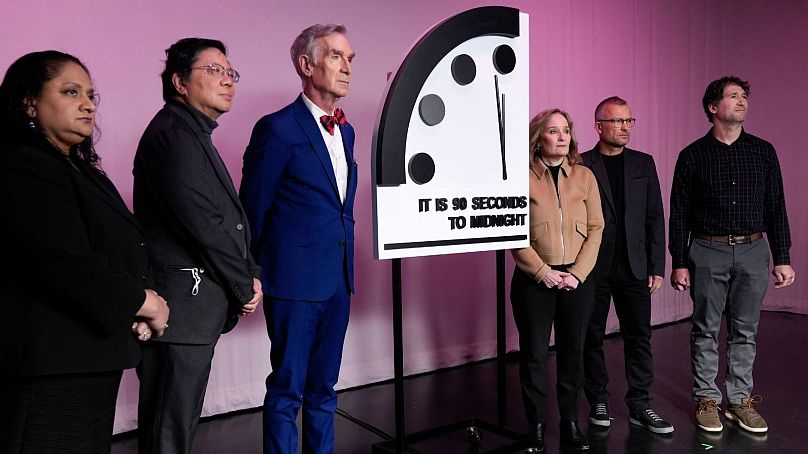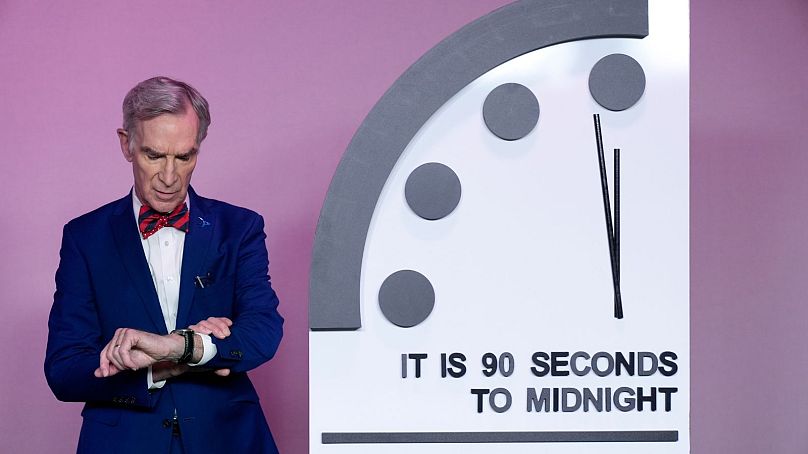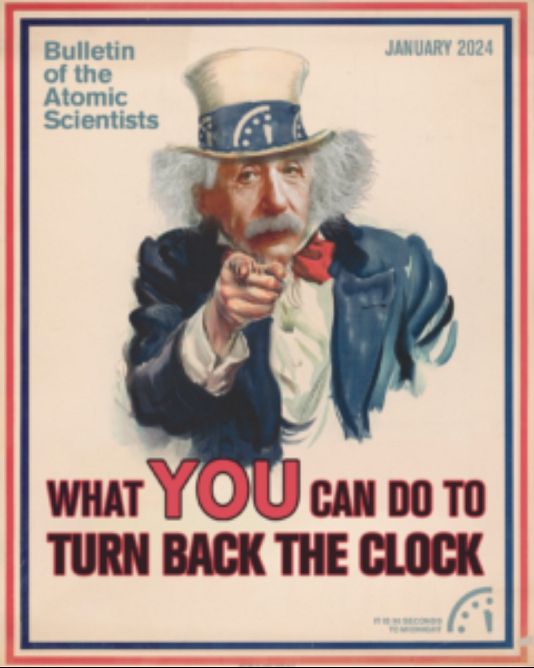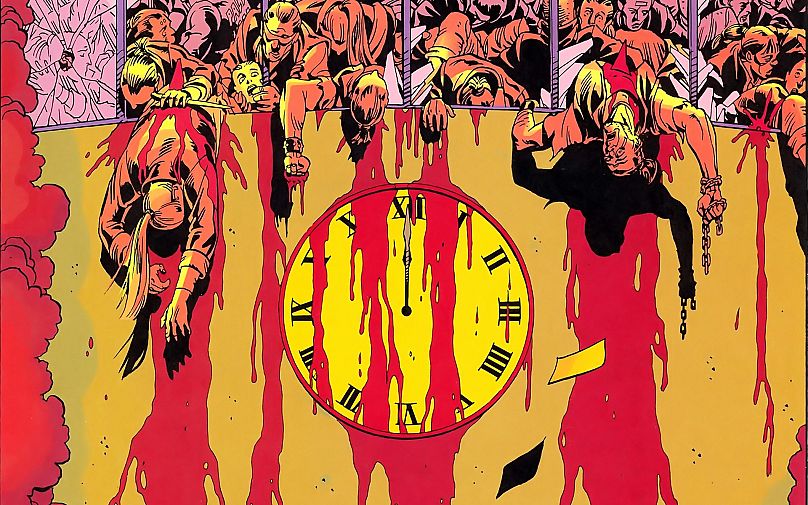The Doomsday Clock is still at 90 seconds to midnight. But what does it mean, how does an Oscar contender come into it, how doomed are we really, and where have you heard of the clock before?
Christopher Nolan's Oppenheimer may be leading the Oscar race, but the celebrated physicist is in the headlines for a much bleaker reason this week, as the organisation J. Robert Oppenheimer co-founded in 1945 has issued yet another stark warning to humanity.
For the second year running, Earth is close to the apocalypse.
Oh, where are our manners? Hope you’re having a nice day.
We're doomed.
The Bulletin of Atomic Scientists, pointing to its famous “Doomsday Clock” that shows 90 seconds till midnight, made the annual announcement yesterday (Tuesday 23 January). It cites nuclear threat in Russia's war on Ukraine, the Oct. 7 attack in Israel, worsening climate-related disasters, and the danger of generative artificial intelligence.
"Conflict hot spots around the world carry the threat of nuclear escalation, climate change is already causing death and destruction, and disruptive technologies like AI and biological research advance faster than their safeguards," said Rachel Bronson, the Bulletin's president and CEO.
“Last year, we expressed amplified concern by moving the clock to 90 seconds to midnight, the closest to global catastrophe it has ever been,” she continued. “The risks from last year continue with unabated veracity and continue to shape this year.”
Bronson added that keeping the clock unchanged from the prior year is "not an indication that the world is stable."
No big surprise there - but hardly cheery, is it?
What is the Doomsday Clock?
The answer to this question goes back to the foundation of The Bulletin of Atomic Scientists.
The organisation was established in 1945 by scientists including J. Robert Oppenheimer and Albert Einstein. They had seen the devastating effects of nuclear weapons two years earlier, at the end of World War II, on the Japanese cities of Hiroshima and Nagasaki. They wanted to warn the public and put pressure on world leaders to make sure nuclear weapons were never used again.
The group devised the Doomsday Clock in 1947, as a way to symbolize how close and likely humanity is to catastrophe from man-made threats. The minute hand would shift in response to changing world events, with midnight representing complete annihilation.
The clock was originally a design for a magazine cover, drawn by artist Martyl Langsdorf, who was married to a physicist, Alexander Langsdorf, who worked on the Manhattan Project while at the University of Chicago. The design was reimagined in 2007 by graphic designer Michael Bierut.
The initial setting of the metaphorical clock was seven minutes to midnight, and ever since 1947, we’ve been moving closer toward extinction.
Each year, the clock’s new time position is announced in late January by the Bulletin’s Science and Security Board. This is a group of the world's most prominent scientists and experts, with diverse backgrounds. They meet twice a year to discuss events, policies and trends, to better consult with colleagues across a range of disciplines, and seek the views of the Bulletin’s Board of Sponsors, which includes multiple Nobel laureates.
According to the group’s website, their mission is to “gather a diverse array of the most informed and influential voices tracking man-made threats” in order to inform the public and the world at large.
The Chicago-based nonprofit also stresses that the Doomsday Clock is meant as a call to action and a warning to politicians that danger is coming but it is within their power to do something about it. The Bulletin is also keen to stress that the clock is not meant as a prediction of the future but an indication of where we are now. On its website, it likens itself to a “doctor making a diagnosis”.
And in case you were wondering, the actual physical Doomsday Clock is located at the Bulletin offices in the lobby of the Keller Center, home to the University of Chicago Harris School of Public Policy.
How doomed are we in 2024?
Very. The hands of the clock have moved 25 times since its inception, and we’ve never been so close to our demise.
Again, hope you’re having a smashing day.
The clock first moved closer to midnight in 1949, following the first Soviet nuclear test, which officially started the nuclear arms race.
A notable change happened in 1953 when the US tested its first thermonuclear device in as part of Operation Ivy. This remained the clock's closest approach to midnight (tied in 2018) until 2020, when we moved from minutes to seconds.
That year, it was cited that the failure of world leaders to deal with the increased threats of nuclear war, such as the end of the Intermediate-Range Nuclear Forces Treaty (INF) between the US and Russia as well as increased tensions between the US and Iran made the time move from 2 minutes to 100 seconds to midnight.
Add the continued neglect of climate change, which led The Bulletin to conclude that the issues causing the 2020 adjustment were "the most dangerous situation that humanity has ever faced."
Three years later, we shaved off another 10 seconds, due largely to the Russian invasion of Ukraine, North Korea resuming its nuclear rhetoric, the continuing threats posed by the climate crisis, and the breakdown of global norms and institutions set up to mitigate risks associated with advancing technologies and biological threats such as COVID-19.
In 2024, the clock remained set at 90 seconds to midnight - the closest to global collapse it has ever been – and while no change could be mildly comforting, scientists warned that it was not an indication of stability.
The Bulletin has said the clock could be turned back if leaders and nations worked together, and specifically noted powerful countries that have the capacity to do so, including the US, China and Russia.
Hope springs eternal.
What’s the farthest we’ve been to nuclear Armageddon?
The 90s were pretty sweet – the music was great, 1999 remains a damn fine year for cinema, and those years represented some doomsday progress.
Years like 1990 and 1995 saw humanity in the double digits (10 and 14 minutes, respectively). The fall of the Berlin Wall and the Iron Curtain, along with the reunification of Germany, meant that the Cold War was nearing an end.
1991 represents our least panicky year, with a whopping 17 minutes to midnight, the farthest from midnight the Clock has been since its inception. This was due in part to the US and the Soviet Union signing the first Strategic Arms Reduction Treaty, and the dissolution of the Soviet Union.
As for the aforementioned 1995, we may have lost 3 minutes compared to 1991, but a full quarter of an hour away from Armageddon feels comforting compared to our current 90 seconds.
The Doomsday Clock in pop culture
The metaphor of the Doomsday Clock has seeped into popular culture over the years.
From the comic books to music, and TV series and feature films, there are chances you’ve come across the image before.
Some of the earliest mentions in music were in a 1980 single by Wah! Heat, ‘Seven Minutes to Midnight’, followed by the Iron Maiden song ‘2 Minutes to Midnight’ four years later.
Much later on, Linkin Park named their 2007 album ‘Minutes To Midnight’, in reference to the Doomsday Clock. Their music video for 'Shadow of the Day' represents the Doomsday Clock as an actual clock with it reaching midnight at the end of the video.
The clock has been namechecked in literature more than once, famously in Stephen King’s 1987 novel "The Tommyknockers", in which King wrote, as an homage to The Bulletin’s work: “The Mideast was getting ready to explode again, and if there was shooting this time, some of it might be nuclear. The Union of Concerned Scientists, those happy folks who kept the Black Clock, had advanced the hands to two minutes to nuclear midnight yesterday, the paper reported.”
It’s also hard to ignore the recurring visual theme of the Doomsday Clock in Alan Moore and Dave Gibbons's seminal "Watchmen" graphic novel series (1986–87), its 2009 film adaptation, as well as its 2019 television miniseries sequel. The clock is everywhere in the source material and its adaptations, an ominous reminder of humanity’s inescapable fate.
Other famous examples in popular culture include two doctors. Dr. Strangelove or: How I Learned to Stop Worrying and Love the Bomb, Stanley Kubrick’s 1964 satirical masterpiece, and Doctor Who.
The good Herr Doktor references the clock, and the whole narrative revolves around the doomsday machine MacGuffin, which is supposed to be a nuclear deterrent. Doomsday devices were incredibly present in literature and art throughout the 20th century, due to the advances in science and technology that made world destruction a credible scenario. The term "doomsday machine" is attested from 1960, but it’s Strangelove who made it enter common parlance.
As for everyone's favourite timelord, the title of the 1982 Doctor Who episode "Four to Doomsday" references the Doomsday Clock, and in the 2017 episode "The Pyramid at the End of the World", the Monks changed every clock in the world to three minutes to midnight as a warning about what will happen if humanity does not accept their help.
More recently, the K-pop phenomenon BTS have referenced the Doomsday Clock in their song 'Zero O’Clock' on their 2020 album '7'.
If those delightful musical scamps can get with the programme, surely we can. And if they can’t get humanity back on track, what hope is there?
Good luck to you, dear reader, and see you next year for another time change.
Hopefully we’ll move backwards this time, as we can ill afford to lose more seconds.















